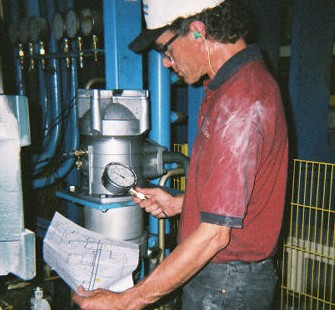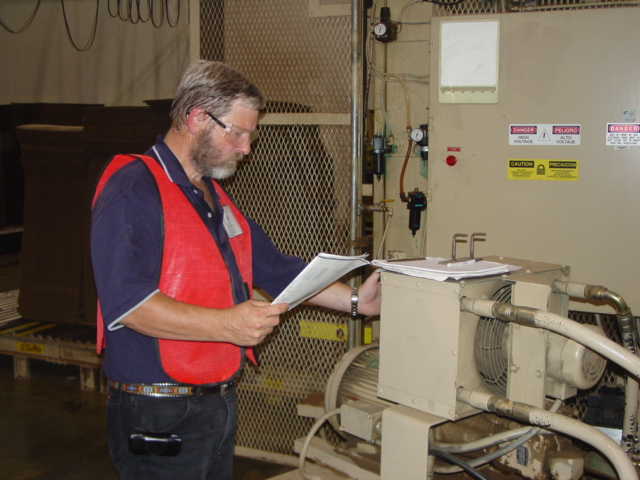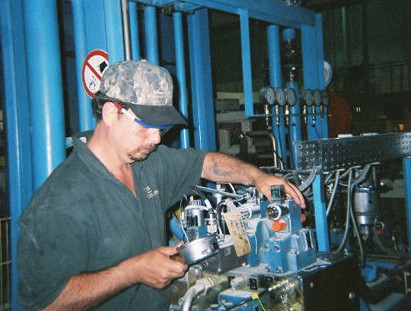| | |
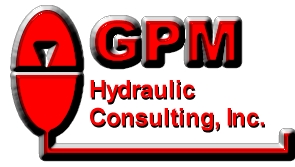
P.O. Box 1376
Monroe, GA 30655
(770) 267-3787
gpm@gpmhydraulic.com |
| February 2014
For an archive of past newsletters, please visit:
http://www.GPMHydraulic.com/newsletter_archive/
 Like Us On Facebook Like Us On Facebook
|
|
 CLICK HERE to share the GPM Newsletter CLICK HERE to share the GPM Newsletter
|
"Troubleshooting Hydraulics" Newsletter
www.gpmhydraulic.com |
|
| In This Issue
1. Water In Your Oil Can Do Real Damage
2. Call GPM For Emergency Troubleshooting
3. Our NEW Accumulator Safety DVD
4. Is It Time For A Hydraulic Reliability Assessment At Your Plant?
5. Parts Changer or Troubleshooter? Take the Quiz!
6. 2014 Hands-On Public Reliability & Troubleshooting Workshops |
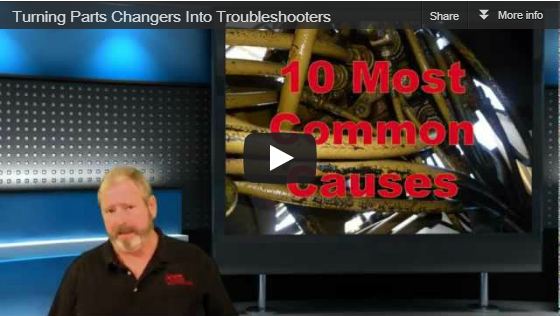 |
|
| 1. Water In Your Oil Can Do Real Damage |
|
Yes, it's true what they told you in school chemistry class. Oil and water do not mix. That is, while water is the universal solvent - most substances dissolve with it, but oil will not. This is because the water molecule is polar. By this we mean that one side of the water molecule is positively charged while the other side is negatively charged. The two atoms of oxygen cling to each other with the single hydrogen atom on the other side. Oil on the other hand is made of carbon atoms bonded to hydrogen atoms forming hydrocarbon chains. This makes the oil molecule non-polar, thus in a container with both substances, the oil molecules are attracted to each other more than they are to the water molecules.
|
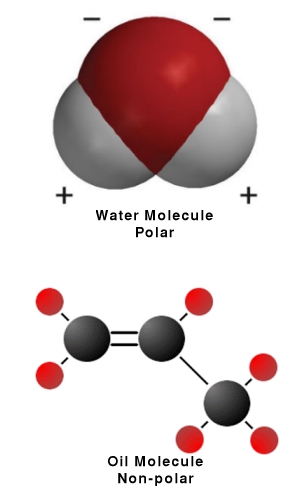
|
|
You may have noticed that when you buy Italian salad dressing, you have to shake it up before putting it on your salad. This is because the vinegar and oil in the dressing separate. You can see in the bottle that the oil is floating on top of the vinegar. But if you shake the bottle, the two will mix long enough to coat your salad. Vinegar is mostly water with a little ascetic acid. Both substances are polar, thus they will dissolve and form a chemical bond. The olive oil however is non-polar so, as the salad dressing sits in the refrigerator the oil will separate from the vinegar. No amount of shaking will make the two permanently bond.
This is not unlike what happens to water in hydraulic oil. All of the moving around in the machine, passing through a pump, extending and retracting cylinders, turning motors, etc. causes the oil and the water to emulsify, or mix for a period of time. Once the emulsified oil and water sits for a while, they will separate again. At least, this would be the case if the system used pure mineral oil and only distilled water could get in.
You will notice that if you taste some of the oil floating on top of the vinegar in your salad dressing bottle, you can faintly taste some of the spices and a little of the vinegar. This is because other ingredients in the dressing act as a surfactant - a substance that will dissolve with both media. This is also the case with hydraulic oil. Some of the additives in the oil as well as some of the impurities in the water act as surfactants causing small amounts of water to be dissolved in the oil. Even this small amount of water can cause trouble with the hydraulic system.
|

|
|
There are three states in which water can exist in oil - dissolved water, emulsified water and free water. Most hydraulic fluids can hold between 200 and 600 parts per million of water in the dissolved state depending on how hot the oil is and how old it is. Old oil can dissolve 3 - 4 times as much water as new oil. Once the oil is saturated, water will suspend in the oil or emulsify. When this happens, the oil will begin to look milky. If water continues to be added to the oil, a layer of free water will form on the bottom of the reservoir. Water has a higher specific gravity than oil, so the oil will float on top of the free water.
Emulsified and free water do the most damage in a hydraulic system, but even high levels of dissolved water can be a problem. Water in the oil can affect its viscosity, its lubricity and its power transfer characteristics. Metals from wear debris can act as a catalyst and cause oxidation leading to higher viscosity and more deposits. It can cause hydrolysis which will result in acids and alcohols which will lead to increased corrosion. Finally, water in the oil can cause premature depletion of oil additives.
Free and emulsified water in the oil can freeze easily if your machine is subjected to the elements. This happened on a carnival ride. When the water in the oil froze, of course it expanded. Water is the only substance that expands when it becomes solid. This caused the cylinders on the ride to explode!
It's easier and cheaper to keep water from getting into the oil than it is to remove it once it's there. Replacing your breather with a hygroscopic filter will keep airborne water from entering the system. It uses a desiccant to remove water vapor from the air. The desiccant is visible through the clear plastic of the housing and should be replaced when it changes color. A rupture in a water heat exchanger can result in water getting into the oil. Leaks in the system can allow rain and water vapor in. Care should be taken when cleaning the reservoir to avoid the ingress of water.
|

|
|
Once the water is in the oil, it can be time consuming and expensive to get it out. Regular draining of the reservoir can remove free water. The size of the reservoir can make a big difference in how well the emulsified water will separate. A centrifuge can also remove free and emulsified water. Coalescers separate water from the fluid by arresting them near the surface of a filter or screen. The droplets get bigger which causes them to fall to the bottom where they can be extracted. Coalescers work well on emulsified water but cannot separate dissolved water. Absorbent filters such as the ones we use in our GPM-120 and other flushing machine models can also remove free and emulsified water quickly and effectively. Dissolved water can only be removed by vacuum dehydration, exposing the oil to a partial vacuum. There are two types - flash distillation and mass transfer. Flash distillation also heats the oil to further boil off more water and it operates at a higher vacuum. This makes the flash distillation process more efficient than mass transfer. Both are expensive. It's best not to let the water into the oil in the first place!
|
|
 |
Alan Dellingerjoined GPM's team of hydraulic instructors and consultants in 2000. He has 16 years of previous hands-on mechanical, pneumatic and hydraulic troubleshooting experience with International Paper Company a leading forest products manufacturer. Alan has trained more than 2000 electricians, engineers and mechanics throughout the US, Canada and Mexico. Alan has been a Keynote speaker for the ExxonMobil Maintenance Symposiums since 2010. Alan is also a experienced CAD draftsmen and technical writer. His customized manuals are used throughout many countries for hydraulic troubleshooting purposes.
|
| 2. Call GPM For Emergency Troubleshooting |
|
Nothing is more expensive than unscheduled down time. GPM’s customers know they can call whenever they have a troubleshooting issue they simply can’t resolve. With over 75 years' experience dealing with hydraulic failures, our consultants have the resources to help troubleshoot whatever hydraulic problem you encounter. Whether you’re experiencing a total system outage, repeated component failure or need a professionally designed hydraulic reliability assessment, the consultants at GPM can help. Call GPM for:
- In-plant Troubleshooting
- Leakage Problems
- Pressure Settings
- Shock Problems
- Hydraulic Reliability Assessments
- Hydraulic Troubleshooting Manual Development
- Startup Consulting and Recommendations
- Heat Problems
- Repeated Component Failures
- Speed Problems
Do you want to learn more about how GPM can help you? Go to http://gpmhydraulic.com/troubleshooting.php.
|
| Al - From the President's DeskAlan, Chris and I have just completed a “Troubleshooting OSB Hydraulics” customized training and troubleshooting manual for a plant in Scotland. We’re looking forward to teaching the program within the coming months! I surveyed the hydraulics on the new press line for Magna’s automotive parts plant in Piedmont, South Carolina two weeks ago. The new press presents new challenges as it is radically different from the German presses we have previously taught. On Tuesday I’m heading out for another hydraulic survey at one of G-P’s OSB plants in South Carolina. I’ve bought some new Taylormade woods and have got a couple of rounds of golf in this year. Considering all the rain and snow we’ve had that’s a good thing! Please let us know how GPM can help you in training, troubleshooting, consulting and reliability assessments. Thank you everyone for your continued support!
|
Where's Jack?Since the last newsletter, I have been working on some new promotional videos. Currently I am working on a 4-1/2 minute video about our Maintenance Basic Hydraulic Troubleshooting and Customized In-Plant Hydraulic Troubleshooting workshops. I just returned from Oxford, MS on a troubleshooting call for a laminated press. We also are getting a good deal of response from my marketing efforts. |
Alan's Back RoadsRecently I taught a 4 day Troubleshooting OSB Hydraulics course in Greyling, MI, a 3 day Troubleshooting Papermill Hydraulics course in Cloquet, MN. While at the GPM headquarters, I have been working on technical writing and drafting for a OSB troubleshooting manual. This manual is being designed for an upcoming Troubleshooting OSB Hydraulics course to be conducted in Inverness Scotland this spring. I have also been involved in the development of a Troubleshooting Sawmill Hydraulics manual for a company located in Idaho.
|
| Following HankSo far, this year has been very busy! I started the the year with two troubleshooting calls at a coil spring manufacturing plant in South Carolina. I also have conducted Troubleshooting Sawmill Hydraulics seminars at West Fraser mills in Leola, Arkansas and Riegelwood, North Carolina. I also conducted an equipment survey for a lumber mill in Dudley, Georgia. In between these trips, I have been working on the development of customized troubleshooting manuals for upcoming workshops.
|
Scallion Pancakes
Ingredients
2 1/2 cups white flour
1 cup warm water
Canola or vegetable oil
Kosher salt
1 bunch scallions
Mix the flour and water to form a smooth dough. Knead by doubling the dough over and pressing down repeatedly until the dough is even more smooth and very elastic. Coat this ball of dough lightly in oil and put it back in the bowl. Cover the bowl with a damp cloth and let rest for 30 minutes
Cut the dough into 4 equal parts. Lightly oil the back of a large baking sheet. Roll out one part of the dough on the back of the baking sheet. Roll until it is a thin rectangle at least 12" x 9".
Finely chop the scallions, lightly brush the top of the dough with oil then sprinkle evenly with chopped scallions and kosher salt. Roll the dough up tightly creating one long snake of rolled up dough. Cut the dough snake into equal parts. Take one half and coil into a round dough bundle. Roll out the coiled dough bundle again into a flat, smooth, round pancake. Heat a 10" skillet over medium high heat, oil it with a drizzle of canola oil. When the oil shimmers, lay the pancake gently int he pan. Cook for 2 minutes on one side. Flip and cook until golden brown. Cut into wedges and serve hot with soy sauce or your favorite dipping sauce. |
Chris's BlogI conducted a Maintenance Basic Hydraulic Troubleshooting workshop in Dudley, GA and assisted Hank with a site survey for their upcoming machine-specific workshop. I have been spending the rest of my time developing manuals for worshops that are coming up.
|
| 3. Our NEW Accumulator Safety DVD |
Some of you may be aware that our Accumulator Safety DVD What You Don't Know About Accumulators CAN KILL YOU! had to be pulled from our shelves because of audio problems in the master. It was impossible to repair, so the DVD had to be remade from the ground up. Naturally this took us quite a while, but we are pleased to announce that it is again available with all new footage and packed with even more valuable accumulator safety information than before!. If you only buy one safety training aid this year, this should be it. The single most dangerous component on any hydraulic machine is made easy to understand in this DVD. In this two hour DVD is included:
What Accumulators Do
Pre-charging an Accumulator
Piston Accumulators
Bladder Accumulators
Safely Replacing a Bladder
Accumulators Used with Fixed Displacement Pumps
Accumulator Dump Valves
Accumulators Used for Shock
Accumulator Safety
Operators and technicians alike, anyone who works on or around a machine with an accumulator should see this DVD. It could make the difference between working safely and serious injury or DEATH!
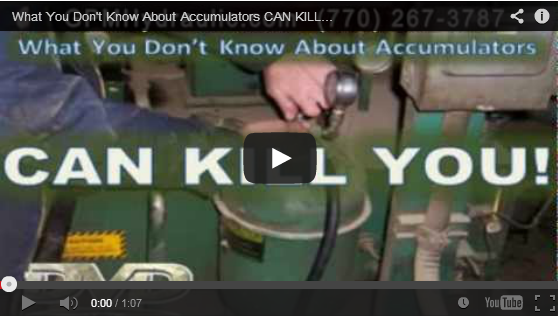 CLICK HERE to learn more and order securely online or call Robin at (770) 267-3787.
CLICK HERE to learn more and order securely online or call Robin at (770) 267-3787.
|
| 4. Is It Time For A Hydraulic Reliability Assessment At Your Plant? |
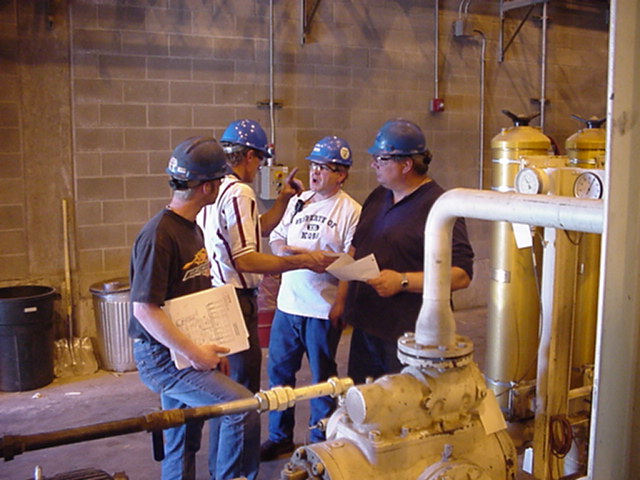
The only preventive maintenance and reliability functions that most plants perform is to change the filters regularly and to check the oil level. When the machine fails, there is little or no information about the system to refer to when troubleshooting. Our consultant will first perform a customized Reliability Assessment on each of your in plant machines. You will receive a Reliability Report on each system with recommendations for immediately improving the system operation, shock, heat, leakage, speeds, etc. You will also be provided with a Reliability and Preventive Maintenance Schedule that can be used to check the condition of the system on a regular basis, reducing un-scheduled downtime. The recorded information will also provide a valuable reference for troubleshooting if a failure of the machine should occur. Pictures will be included throughout the report to identify the reliability test points in the system. The Assessment will be conducted while the machine is operating and will include the following:
- Testing of the pump(s) to determine if the
proper volume is being delivered to the system. By making this test
regularly the pump can be replaced on a down day and not when it fails
and interrupts production.
- Checking the accumulators to make sure they are properly pre-charged which is necessary to achieve the desired speed to maintain production.
- On any given hydraulic system, there should
be some lines that are hot (above 130 degrees), warm (100-130 degrees),
and cool or at ambient temperature. By checking the temperature of
these lines on a regular basis a component failure can be found before
the system fails completely.
- One of the main issues in a hydraulic system
is leakage. One drop of oil that drips once per second will lose 405
gallons a year. If leakage is occurring there is a reason for it. Our
consultant will identify the cause of the leak and recommend the
necessary fix to prevent it from occurring in the future.
- One of the biggest problems in systems today
is that the pressures are out of adjustment which causes excessive
force, heat, leakage and wasted electrical energy. Our consultant will
identify any pressure setting issues and many times correct them during the assessment.
- Check to verify that the pipe and tubing
clamps are properly spaced and are of the proper type.
Make sure that the hoses are properly installed to prevent pre-mature
failure and oil loss.
- Check the condition of the filters if a
visual or electrical indicator is available.
- Verify that the air and water heat
exchangers are operating properly to reduce the oil temperature to an
acceptable level. If the oil temperature is above 140 degrees then oil will start breaking down causing sludge and varnish in the system.
- Check the condition of the breather cap and
recommend a maintenance schedule.
- Sound checks to determine pump cavitation,
aeration or valves bypassing in the system.
Call (770) 267-3787 to schedule your Reliability Assessment.
|
| 5. Take the Quiz! |
Our Online Hydraulic QuizIf you are wondering if you or your maintenance techs should attend our basic class prior to attending a customized machine specific workshop, our online quiz can tell you quickly. A score of less than 80% suggests that our Maintenance Basic Hydraulic Troubleshooting workshop would save you downtime and better prepare you or your staff for the advanced workshop. Or maybe you have already attended one of our workshops and would like to see how much you have learned. Either way, you should find our Online Hydraulic Quiz revealing and well worth your time. |
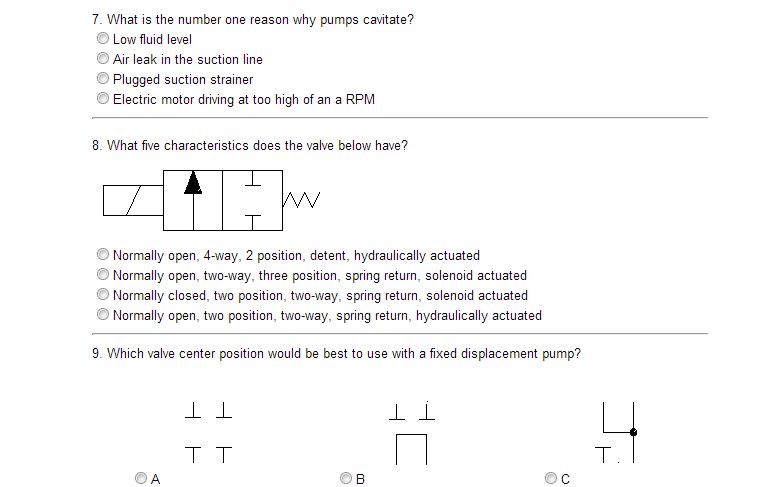 |
| 6. 2014 Hands-On Public Reliability & Troubleshooting Workshops |











